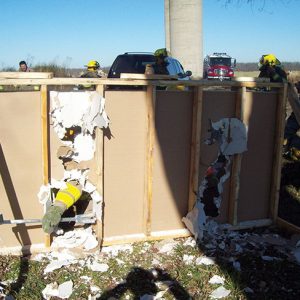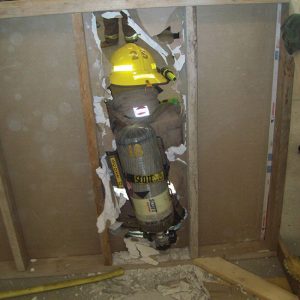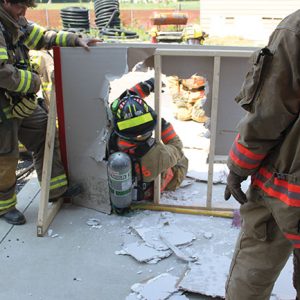
Back to Basics: Firefighter survival series
By Mark van der Feyst
Features Mark van der Feyst SCBA Photo 1: To initiate a wall breach, use a hand tool to first punch an inspection hole through the wall.
Photo 1: To initiate a wall breach, use a hand tool to first punch an inspection hole through the wall. Whenever we mention the term firefighter survival, we are referring to what an individual can do rescue themselves from a bad situation. This is usually accomplished with an evasive escape technique.
Before we start our detailed look at these escape techniques, I want to go over a few important points. Firstly: Prevention is key! If we can prevent the need to use an escape technique, then we are better off. Being able to recognize signs of impending flashover, signs of building collapse, reading the fire conditions and smoke movement, just to list a few, is priority for the firefighter. These important skills will save your life by preventing the chance of losing it.
The second important point to remember is that evasive techniques are a last resort option. The techniques that we are going to look at are evasive – they are not designed to be used or integrated into a regular daily routine. They are there as an option to exercise when you are in a situation where if you do nothing you are going to die, but if you do something unorthodox or non-textbook, then you will live.
The last important point to remember is training is essential for both the technique and the equipment being used. Because these techniques are not a part of our operational routine, they need to be practiced all the more. It will not do you any good to train on the equipment and the technique once, never train on it ever again, then have to use it when faced with a life and death situation. This will set the firefighter up for failure.
The first escape technique we’ll discuss is the wall breach. This is where the firefighter is unable to locate a door or a window but has a need to get out now. Wall breaching is where the firefighter will buy themselves some more time to get out. By going to another room, the firefighter will hopefully enter a tenable space that will allow them to locate a window or a door to get out.
Why breach a wall in the first place? This is where the fire conditions of the room or the environment are becoming untenable — they are so severe that staying there is deadly. Conditions such as impending flashover will be a good reason to breach a wall to get to another tenable area to buy some more time. An extra two to three minutes will be all that is needed to get from the tenable room to out of the building before being trapped by the rapid-fire event.
Every firefighter needs to know their wall construction and what types of walls will be found inside certain buildings. In a newer residential building, common wall construction will be wood lumber and drywall for interior walls with the exterior walls being comprised of lumber and brick or siding (wood, vinyl, etc.). In older residential structures, it is common to find lath and plaster on the interior walls.
In an office type of building the interior walls can be metal studs with drywall with the exterior walls being made from concrete, concrete block, brick, or sometimes metal siding. In some commercial buildings, it will be the same as the office set up, but some interior walls may be made of concrete. This will be true with industrial buildings as well.
Knowing the wall construction of the structure that you are in will help with determining if a wall breach is possible or not. In a residential structure this will always be possible. In other types of buildings, the wall type will dictate. The other aspect of wall knowledge is the spacing between the studs, commonly 14-inches inside with 16-inches on centre. This will be more than enough room for a firefighter to breach and get through.
Wall breach begins with the firefighter working below the midpoint of the wall height – this is because the intense heat and the fire conditions are going to force the firefighter to have to be this low. Using their hand tool such as a halligan (see Photo 1), they will punch an inspection hole through the wall. This is done to make sure that the room adjacent is going to be tenable and not worse than the room they are in currently. Once the inspection hole has been made and we see tenable conditions, the firefighter will continue to punch the wall with their tool to create a large enough opening.
In Photo 2, the firefighter has completed punching the wall and making their hole. They then take their hand tool, sound the floor in front of them to make sure there is a solid floor there to receive them, then place the tool just at the base of the wall and floor. This is to landmark your tool – you will know where the tool is and can feel for it. Notice that the opening created is not “pretty” or “engineered” in size. It is a violent opening allowing the firefighter to pass from one room to the next.
Next the firefighter will sit their SCBA cylinder right inside the opening as seen in Photo 3. This allows for the biggest part of the SCBA to be passed through the opening first. The firefighter will then lift their one arm up and over their head and pass it through the opening. At this point, half of their upper torso should be through the opening – they can then pass their head through by looking straight ahead and following their head backwards.
In Photo 4, you will see that the firefighter can now bring their other arm into the opening, allowing them to use their feet to push the rest of their body through the opening. This can be accomplished by twisting and turning their body while pushing with their feet.
Once through the opening, the firefighter can grab their tool and head for the nearest exit be it a window or a door. Once out of the building, they need to let Command know and call off the mayday.
Mark van der Feyst has been in the fire service since 1999 and is currently a full-time firefighter with the WFD. Mark is an international instructor teaching in Canada, the United States, FDIC and India.
Print this page


